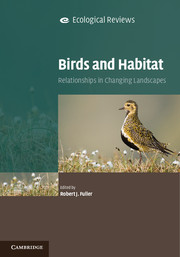Book contents
- Frontmatter
- Contents
- List of Contributors
- Preface
- Part I The complexity of patterns and processes
- Part II Case studies of habitat use and selection
- Part III Wider perspectives
- Chapter Fifteen What is habitat quality? Dissecting a research portfolio on shorebirds
- Chapter Sixteen Understanding individual life-histories and habitat choices: implications for explaining population patterns and processes
- Chapter Seventeen Insufficient adaptation to climate change alters avian habitat quality and thereby changes habitat selection
- Chapter Eighteen Australian birds in a changing landscape: 220 years of European colonisation
- Chapter Nineteen Birds in cultural landscapes: actual and perceived differences between northeastern North America and western Europe
- Chapter Twenty Birds and their changing habitat: thoughts on research and conservation strategies
- Species index
- Subject index
- References
Chapter Eighteen - Australian birds in a changing landscape: 220 years of European colonisation
Published online by Cambridge University Press: 05 December 2012
- Frontmatter
- Contents
- List of Contributors
- Preface
- Part I The complexity of patterns and processes
- Part II Case studies of habitat use and selection
- Part III Wider perspectives
- Chapter Fifteen What is habitat quality? Dissecting a research portfolio on shorebirds
- Chapter Sixteen Understanding individual life-histories and habitat choices: implications for explaining population patterns and processes
- Chapter Seventeen Insufficient adaptation to climate change alters avian habitat quality and thereby changes habitat selection
- Chapter Eighteen Australian birds in a changing landscape: 220 years of European colonisation
- Chapter Nineteen Birds in cultural landscapes: actual and perceived differences between northeastern North America and western Europe
- Chapter Twenty Birds and their changing habitat: thoughts on research and conservation strategies
- Species index
- Subject index
- References
Summary
European colonisation of the Australian continent has caused immense changes in birds and their habitats during a timespan of just 220 years. A diverse and unique range of ecosystems and avifaunas is today in a state of flux as some species manage to exploit new and modified environments, while others fail to adapt, decline in abundance and become regionally uncommon or extinct (Barnard, 1925; Barnard, 1934; Blakers et al., 1984; Saunders and Curry, 1990; Recher, 1999; Barrett et al., 2003). In this chapter we consider the history of human occupation and scale of landscape change in Australia, the distinctively evolved life-history characteristics and habitat relationships of Australian birds, the type of contemporary landscape variation within Australia, and the nature of bird species and community responses to landscape change. This chapter is by no means an exhaustive review of the bird ecology literature in Australia, but rather provides an insight into the major landscape changes throughout Australia as a result of European colonisation, with a focus primarily on its impact on terrestrial birds. We examine potential reasons for differences and similarities in avifaunal responses to landscape change between Australia and Europe. We also highlight recent approaches to developing unifying conceptual frameworks for the complex range of species’ responses to landscape change within Australia, and outline their broad relevance to guiding efforts to conserve and restore bird populations and their habitats in Europe and elsewhere.
History of habitat change and human occupation: Australia vs. Europe
The history of anthropogenic landscape change in Australia differs substantially from that of Europe (Fig. 18.1). Australia is estimated to have been occupied by humans for as long as 60 000–70 000 years (Briscoe and Smith, 2002). By the late Holocene the native vegetation of large areas had been transformed as a result of ‘fire stick farming’, a technique used by Aboriginal people to burn vegetation to facilitate hunting, food gathering and movement through the landscape (Archer et al., 1991; Bowman, 2000). The practice of fire stick farming over thousands of years altered the composition of plants and animals and has been linked with megafaunal extinctions in the Pleistocene (Miller et al., 2005). By the time European ships were regularly sighted along the horizon (c. 1700s), most Australian vegetation and fauna were well adapted to fire.
- Type
- Chapter
- Information
- Birds and HabitatRelationships in Changing Landscapes, pp. 453 - 480Publisher: Cambridge University PressPrint publication year: 2012
References
- 5
- Cited by



